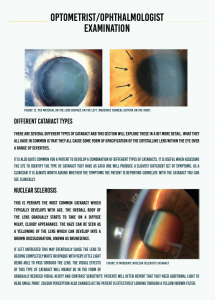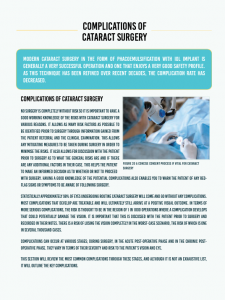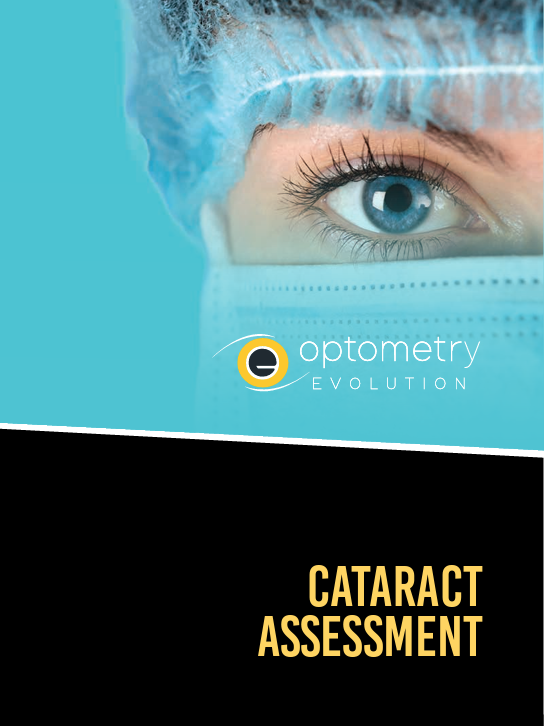Assessing patients with cataract is something that almost every Eyecare professional is involved in to some degree due to the volume of patients requiring treatment for this condition. Community optometrists are on the front line of detecting and referring patients with cataract while clinicians in the hospital service and other cataract surgery providers are involved in the assessment and listing of patients for surgery. This 40 page booklet has been developed to help anyone who is involved in examining and assessing patients through the cataract treatment journey.
![]() The cataract assessment booklet walks through the start of the cataract pathway which begins with referral from the community optometrist in the majority of cases. It covers the information that should ideally be included in a complete referral. This is followed by guidance for clinicians who are tasked with vetting referrals. It then gives an overview of the overall cataract assessment process undertaken by the service providing surgery before the patient is listed. This is broken down into the nurse assessment followed by the examination by the optometrist or ophthalmologist who will often work with the nurse in a joint clinic.
The cataract assessment booklet walks through the start of the cataract pathway which begins with referral from the community optometrist in the majority of cases. It covers the information that should ideally be included in a complete referral. This is followed by guidance for clinicians who are tasked with vetting referrals. It then gives an overview of the overall cataract assessment process undertaken by the service providing surgery before the patient is listed. This is broken down into the nurse assessment followed by the examination by the optometrist or ophthalmologist who will often work with the nurse in a joint clinic.
 Ophthalmic nurses will find this guide helpful as it covers the range of checks and measures that they typically performed in this part of the assessment including general health checks, ocular biometry and a variety of visual and ocular measurements. Biometry is a crucial element of an accurate assessment. The basis of biometry is covered along with how to minimise error and how to review the results for any inconsistencies.
Ophthalmic nurses will find this guide helpful as it covers the range of checks and measures that they typically performed in this part of the assessment including general health checks, ocular biometry and a variety of visual and ocular measurements. Biometry is a crucial element of an accurate assessment. The basis of biometry is covered along with how to minimise error and how to review the results for any inconsistencies.
The next stage of assessment will consist mainly of a dilated examination by the optometrist or ophthalmologist. This section of the guide gives a run through the examination of the eye including anterior segment, lens and posterior pole, highlighting the key clinical features to look for. These examinations are designed to highlight any ocular co-morbidities or risk factors which may have a bearing on the safety or potential success of surgery. Following the clinical examination the guide reviews the range of factors which feed into the clinical decision making process and how these findings may be discussed with the patient. If the patient is to be listed for surgery, the process of patient discussion and gaining consent is also covered.
 The final section of this guide explores some of the complications that can arise from cataract surgery, which is important for anyone involved in the delivery of this service to be aware of and be able to counsel patients on.
The final section of this guide explores some of the complications that can arise from cataract surgery, which is important for anyone involved in the delivery of this service to be aware of and be able to counsel patients on.
This booklet will be useful for community optometrists as the clinical examination of the patient at the point of referral closely mirrors that of the clinician who is examining them at the time of listing. It will be useful for Ophthalmic Nurses who work on this pathway and also for any optometrist or ophthalmology trainee who may be learning the skills of assessing patients for surgery.
This booklet can be used on its own but also forms a significant part of the learning material for the Cataract Assessment Course for Ophthalmic Nurses which is run by Optometry Evolution. If this training would be useful for your team please email stanleykeys1@icloud.com.
The development of this booklet was very kindly supported by Scope Ophthalmics along with a variety of contributors who kindly allowed the use of clinical images, for which I am very grateful and have credited in the acknowledgment section of the booklet.
To order a copy of this booklet please see in the shop section of this website or follow the link.
Thank you
Stanley Keys

